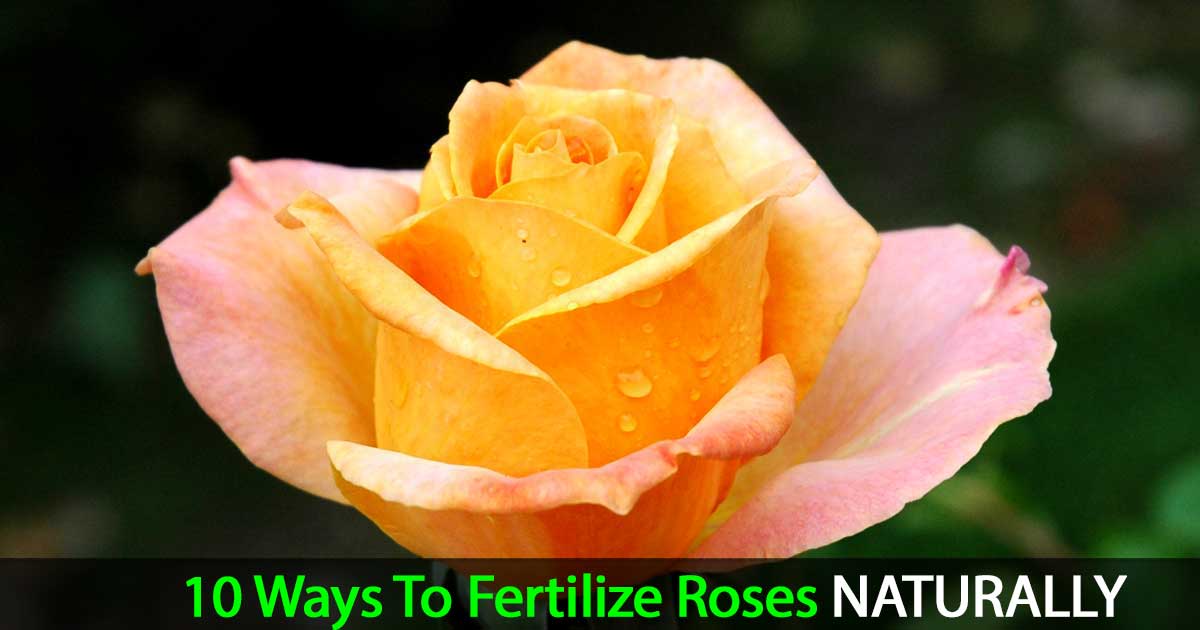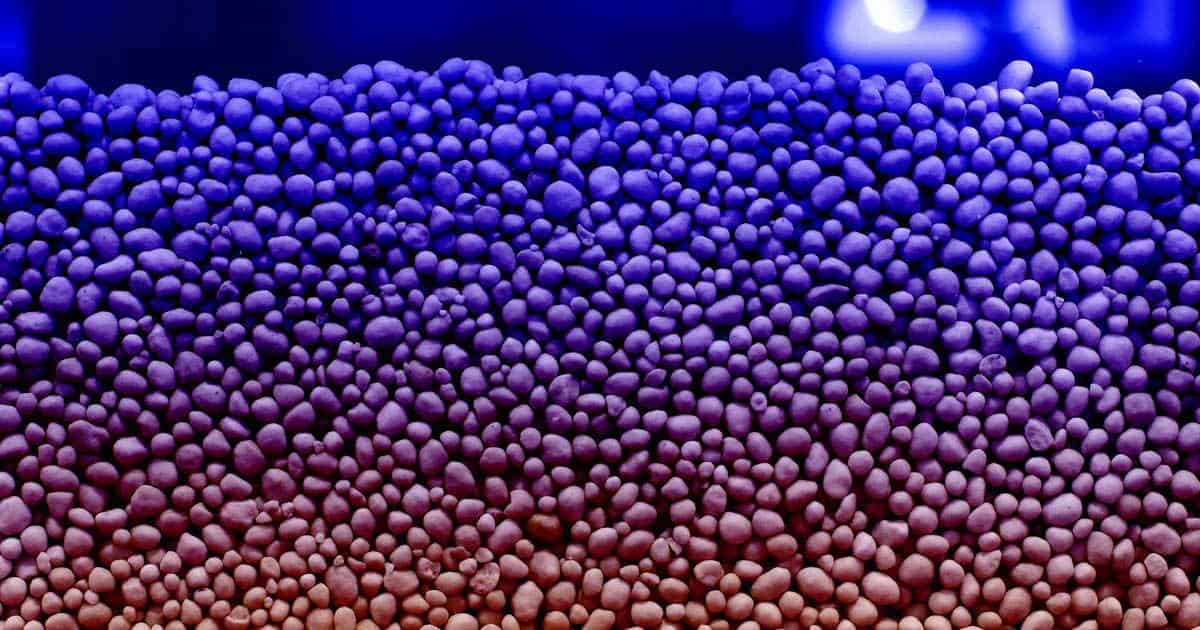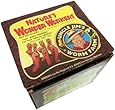Let’s be honest! When it’s time to fertilize roses, for many home gardeners, purchasing of a bag of rose fertilizer is a purchase of mystery.


https://plantcaretoday.com/fertilize-roses-naturally.html
This need not be; with a little knowledge anyone can select a fertilizer to fit any particular need. You can buy with the assurance that you’ve obtained the proper ingredients for maximum results assured each bag.

By law, all fertilizers carry numbers of the guaranteed plant food such as 10-6-4 or 7-8-5.
The three numbers always indicate the number of units of:
- Nitrogen
- Phosphate
- Potash
…and always in this order.
Thus a formula of 20-10-5 means:
- 20 units of nitrogen which produces top growth
- 10 units of phosphate which furnishes color and strength
- 5 units of potash which provides strong root growth
While high nitrogen fertilizers tend to give a showy display of top growth, this by itself is not sufficient to assure healthy plant growth.
In fact, an imbalance of nitrogen can give the false sense of security that plants or a lawn are developing beautifully, when in fact the root systems are being starved.
For this reason, it is essential to feed each type of plant the precise, carefully balanced diet which brings maximum beauty and health to the entire plant. For roses, one of the best diet formulas is 7-8-5.
Unfortunately, most packages of rose fertilizers do not give much additional information about the contents. The reason is that individual states have different rules as to “how to express the contents” of-a-package and what can and cannot be listed.
Inasmuch as the fertilizer manufacturer cannot afford to print, fill and inventory different packages for every state, they omit much data and lists only the information and terminology agreed upon by all states where it is sold.
Thus a rule to follow is always ask to see the manufacturer’s literature before you buy.

A combination of slow-feeding organics, fast-acting chemicals, and trace elements is desirable. We all know human nutritional factors such as calories and proteins can be obtained from a variety of sources.
Basic nutrients for plant life also are obtainable from various sources. Many fertilizers are entirely fast acting straight chemicals.
While these give nourishment, it is very temporary nourishment because it leaches from the soil rapidly. Consequently, such a fertilizer would have to be fed very often, which is costly as well as troublesome.
Organic Based Fertilizers Are The Best And Most Economical
When the right organic matter is combined with fast acting chemicals in one fertilizer it produces a dependable combination of fast feeding for quick results and slow feeding for lasting economical results.
As stated above, these elements can be obtained from various sources but the sources are highly important because they control the rate of release or feeding.
Sources of Slow-Feeding Organics
Nitrogen
- Dried blood
- Soy meal
- Animal Tankage
- Cotton seed meal
- Fish meal
Phosphate
- Bone meal
- Dried blood
Potash
- Wood ashes
- Dried manure
*Dried blood is an especially excellent source of organic nitrogen for rose culture.
Sources of Fast-Acting Chemicals
Nitrogen
- Sulfate of ammonia
- Nitrate of soda
- Ammonium nitrate
- Urea
Phosphate
- Phosphate
- Phosphate rock
Potash
- Muriate of potash
- Potassium nitrate
Plants, like humans, can have what could be termed “vitamin deficiencies.” One of the foods which roses need but often miss is the minor or “trace” elements.
These are the minerals of:
- Iron
- Magnesium – Roses love Epsom Salt
- Manganese
- Copper
- Zinc
- Boron
- Molybdenum
To make sure your roses get these elements, buy your rose fertilizer from a well informed dealer who can tell you definitely whether or not their rose food contains trace elements.
Like all other things, fertilizers come in all qualities and prices. You usually get what you pay for. Cheap fertilizers produce questionable results.
In these days of self—service shopping remember to study the package and if possible, ask questions of the store manager. In this way you make sure the fertilizer chosen contains organics and trace elements in addition to chemicals.
10 Natural Fertilizers For Roses
Roses are generally considered as heavy feeders due to their large nutrient intake which affect their health and size positively. Therefore, ensuring that they have the required nutrients and minerals is vital to get beautiful roses in your garden.
The more roses feed, the more they bloom. Roses can survive without much fertilizer, but they will struggle to develop into the beautiful plants they are.
A natural or homemade rose food provides nutrients roses require to develop into healthy, strong plants.
Banana Peels To Fertilize Roses
Eating a banana helps one replenish lost potassium. This is the same case for roses. Banana peels contains high levels of potassium which roses need. Simply throw a peel in the hole before planting the rose.
You can also bury a peel 4” to 6” under soil for them to compost naturally. It helps roses bloom more as it releases the potassium as they decompose.
Using Coffee Grounds On Roses
Roses are acid loving plants. Mix coffee grounds into the soil. It is the nitrogen that helps the roses as they require it for development.
Sprinkle used grounds of coffee on the soil before watering or pour a liquid version on the soil.
If you are using a soil drench, soak 6 cups of coffee grounds in five gallons of water. Let the solution rest for 2-3 days and then saturate the soil around the plant.
Make An Organic Fertilizer Using Coffee Grounds
You can also make organic fertilizer using coffee ground. You will need used coffee grounds, a cookie sheet and newspaper.
- Line the cookie sheet with the newspaper
- Spread the coffee grounds on the sheet and allow them to dry completely
- Sprinkle the ground coffee around the base of the rose plant. Avoid overdoing it as too much acid is not good for the plant.
Coffee grounds work because they are rich in nitrogen, magnesium and potassium which are all important nutrients. This is an addition to their acidic nature.
Use A Seaweed Rose Fertilizer
Seaweed does not need to be washed to remove the salt. Both the dried and fresh versions are considered excellent as a soil amendment. It contains trace elements and it serves as a food source for soil microbes.
Chop a small bucket of seaweed and soak it to five gallons of water, loosely covered. Allow the mixture to steep for two to three days.
Use the mixture to drench the foliage and soil.
- 2 cups work well for a small plant
- 4 cups for medium size plants
- 6 cups for large plants
Use Weeds As Natural Fertilizer
Nettles, horsetail, yellow dock, chickweed and comfrey make wonderful homemade fertilizer. Weeds can be used in several ways to make your own fertilizer or speed up a compost pile.
If the weeds have not flowered, they can be dried in the sun and chopped up to use as mulch. The weeds are highly rich in nitrogen and will not rob plants nutrients.
Starflower (borage) is a herb but it can also be used as a weed. It has the same nutritional properties as comfrey.
The entire plant is dried and put in the compost tumbler. It helps to break down everything and gives extra heat to the compost.
Weeds can also be soaked in water. Place the weeds and add water until the weed is fully covered. Stir weekly and wait for 3-5 weeks for the content to be thick and gooey. Dilute the goo in a ratio or 1:10 and use it as a drench fertilizer.
Add Molasses To Compost Tea
The use of molasses in the compost tea increases the microbes that benefits the bacteria that feed on those microbe.
It’s simple to come up with this molasses fertilizer. Just add one or two teaspoons of molasses in a gallon of water. Water your roses with this mixture for healthier and bigger growth.
Use of Human Urine
This may sound absurd, but if it’s from a healthy human body free of diseases, it’s considered sterile to the roses.
Human urine is rich in nitrogen and urea that contains high levels of potassium and phosphorous. Higher than any fertilizer you can buy from a local vendor.
The ratio of water to urine should be 8:1. Collect a cup of urine and pour it into eight cups of water in a watering can for fertilizing roses.
Pour two cups of the mixture around a small rose, four around a medium plant and six for a large rose.
Using the Grass Clippings
Grass is rich in nitrogen and breaks down with time to enhance your soil. Fill a five gallon bucket with the grass clippings. You can also add weeds too.
Weeds as discussed earlier soak up nutrients from the soil just like the grass. Add water at the top of the bucket and let it stay for one day or two.
Put one cup of your liquid grass fertilizer to 10 cups of water and apply two cups for a small rose, four for a medium one and six for a large rose.
Using Animal Manure To Make Compost Tea
This is one of the fertilizers that is used widely. The composted chicken, cow or horse manure is beneficial to your roses. The more your manure is composted and aged, the better as a fertilizer it becomes.
Add composted manure to a small permeable bag or use an old towel or T-shirt. Make compost tea by placing the “bagged manure” in a 5 gallon bucket of water and place under shade for steeping.
After a few days, apply it to the soil to condition it before you plant. Remember to discard the bag you used. You can also use manure tea for soaking barefoot roses.
Using Dog And Cat Food
Depending on the type of dog or cat food you use, this may not be considered as an organic fertilizer. However, even the cheap stuff used to feed dogs and cats contains micro-nutrients and proteins that are beneficial to the soil.
After you have prepared your garden for planting, sprinkle the dry pet food on the bed. Then turn the water and soil and let it decay naturally.
Cover it with a cardboard until they decomposes to protect the foods from being eaten by wild animals that may visit your garden.
The cardboard is good for trapping moisture and discouraging the development of weeds in your garden. Make sure that the cardboard is wet all the way through plus cover it with mulch.
Ensure that it’s watered thoroughly in every week for 4 weeks. This will leave your soil healthy and fertile for your roses to thrive in.
Alfalfa pellets and soybean from the grain store will also work great for your naturally fertilizer preparation. Check the food use for salt content to avoid the use of pet foods that contain high levels of sodium.
Dry foods containing a minimum of 3% sodium are recommended to support normal growth and development.
Use Fish Tank Water
Fish tank water contains high levels of nitrogen that roses need very much. So instead of pouring the water after cleaning the fish tank, you can replace your regular rose watering with the fish tank water.
Don’t use the excessively dirty water or any moldy water.
Use Worm Castings To Make “Worm Tea”
It’s easy to make homemade worm tea. Starting with a handful of red wiggler worms, set them up with some cardboard and kitchen leftovers.
This will remove toxins and harmful bacteria from the soil that will help fight the diseases that may attack your roses. It also helps to reduce the heavy metal that may be found in organic waste.
Worm casting is rich in nutrients as a little tablespoon can provide enough nutrients to feed 6 inch potted plants for more than 2 months. Watch the video here to see how easy it is to prepare worm casting.
Roses require nitrogen and phosphorus and potassium for them to develop into healthy and colorful plants that they are. The ordinary fertilizers readily available, may have a negative effect on your plants or even make them die.
If possible always use a natural organic fertilizer to ensure your environment is safe and that plant gets the nutrients they require.
This will also save you the cost of buying fertilizers as some of the materials used for the preparation are readily available around your home. Try them for the best roses in your garden.
For further information log on website :https://plantcaretoday.com/fertilize-roses-naturally.html









No comments:
Post a Comment